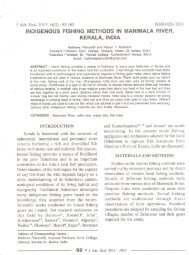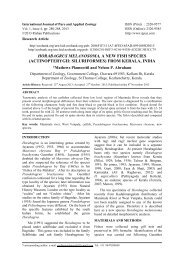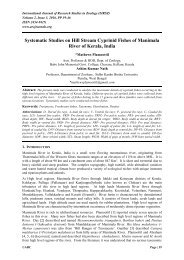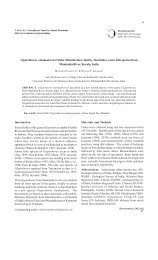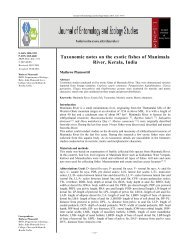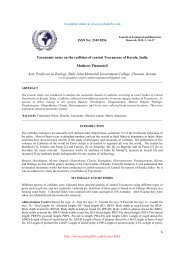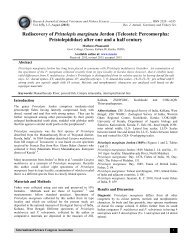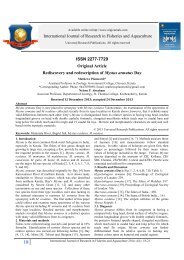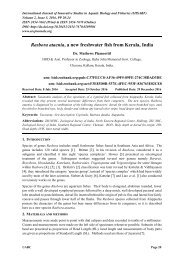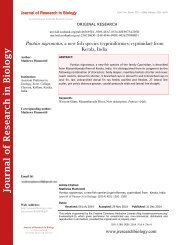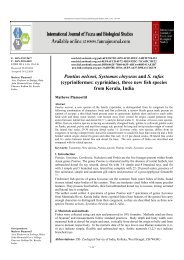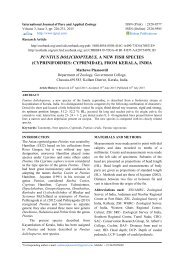You also want an ePaper? Increase the reach of your titles
YUMPU automatically turns print PDFs into web optimized ePapers that Google loves.
Plamoottil, 2015<br />
teeth bearing surfaces. Barbels four pairs; maxillary<br />
barbels short, slender, extending to middle of orbit, never<br />
reach pectoral base or outer opercular margin, reach half<br />
way to pectoral base. Nasal barbels slender, fairly reach<br />
anterior margin of orbit. Inner mandibulars very short<br />
and feeble, origin on either side of mid ventral line, its<br />
length ¾ of the diameter of orbit. Outer mandibulars<br />
originate posterio - lateral to inner mandibulars, reach in<br />
vertical just behind anterior margin of orbit.<br />
Dorsal fin with a small spine and seven branched<br />
rays. Origin of dorsal fin above the middle of pectoral fin<br />
in smaller ones and at the tip of pectoral in larger ones.<br />
Dorsal fin margin convex. Tip of dorsal fin reach the tip<br />
of pelvic fin or 2/3 of length pelvic fin from its origin.<br />
Dorsal fin spine straight, slender, very weak, feebly<br />
ossified and flexible, anterior and posterior edges<br />
smooth. Pectoral fin with a moderately strong spine and<br />
7-8 rays. Anterior margin of spine smooth, posterior<br />
margin with 10-13 small moderate serrations along entire<br />
length. Adipose dorsal fin with a straight margin for<br />
entire length, its anterior end never reach the base of last<br />
dorsal fin ray, but reach above the tip of pelvic fin or a<br />
little in front of the tip of pelvic fin. Considerable<br />
distance between base of last dorsal fin ray and origin of<br />
adipose dorsal fin. Adipose dorsal fin base extending to<br />
about ½ of an eye diameter behind last anal ray. Inter<br />
dorsal distance 8.0-12.3 in percent of SL and 41.7-47.6<br />
in percent of adipose dorsal fin base. Pectoral fin margin<br />
convex posteriorly. Tip of pectoral fin just reach or reach<br />
a little behind the level of origin of dorsal fin. Pelvic fin<br />
origin at vertical through posterior end of dorsal fin base<br />
and with, 5 rays and with a convex margin. Tip of it<br />
reach below anterior end of adipose dorsal fin base or a<br />
little behind it, it never reach anal fin origin but reach or<br />
reach nearer to the anal opening. Anus and urino genital<br />
openings are located on the mid ventral line in between<br />
ventral fin and anal fin origin.<br />
Origin of anal fin base in a vertical through ¼ of<br />
the length of adipose dorsal fin from its anterior end,<br />
located nearer to pelvic fin than to caudal fin base, with<br />
four undivided rays and 9-10 branched rays. Distal<br />
margin of anal fin slightly convex. Tip of anal fin never<br />
reach caudal fin base. Caudal peduncle depth 50.0-53.5<br />
in percent of its length. Caudal fin deeply forked with<br />
rounded lobes having 17 principal rays.<br />
Coloration: Body and fins yellow; a small brownish<br />
black triangular spot present in front of rayed dorsal fin<br />
base; a triangular dark or light brownish black spot<br />
present on caudal base. A thin brownish black line passes<br />
through mid lateral line.<br />
Etymology: The specific epithet ‘<strong>flavus</strong>’ is a Latin word<br />
meaning ‘light yellow’ refers to the color of the body of<br />
the new fish.<br />
Distribution: Currently known to occur only at<br />
Paduthode of Manimala River, Kerala, India.<br />
Habitat: The river stretch of Manimala River at<br />
Paduthode, the type locality of <strong>Batasio</strong> <strong>flavus</strong>, is<br />
generally occupied by sand or sandy gravel with<br />
occasional presence of bed rock or black clays. Width<br />
and depth in this area are 45.0-125.0 m and 0.3-6 m<br />
respectively; the bank height is 4.0-5.0 m above the<br />
general water level in summer season. The area is<br />
blanketed by moderate to dense riparian vegetation;<br />
intermittent occurrence of low riparian vegetation<br />
noticed at certain places.<br />
DISCUSSION<br />
The new species differs from <strong>Batasio</strong><br />
travancoria Hora & Law (1941) of Pamba and Kallada<br />
Rivers of Kerala in many characters; In <strong>Batasio</strong><br />
travancoria body is grey or brown (vs. yellow in new<br />
species), median cephalic groove appear as double<br />
fontanels (vs. single), occipital process can be seen<br />
externally (vs. not seen externally) and adipose dorsal fin<br />
originates immediately behind the rayed dorsal fin (vs.<br />
AD inserted behind a considerable distance from RD).<br />
New species have a slender body (BDA 14.0-14.8 % SL<br />
vs. 14.8-17.3 in B. travancoria), flatter head (HD 11.1-<br />
1802 Journal of Research in Biology (2015) 5(5): 1799-1808




